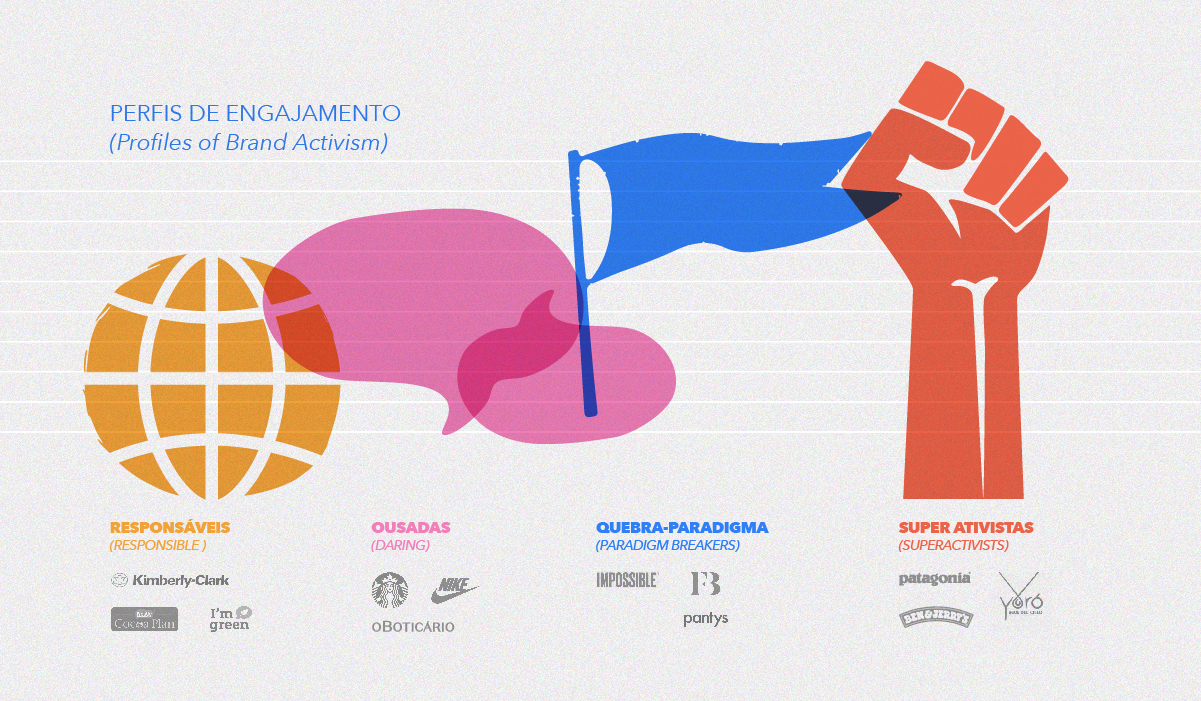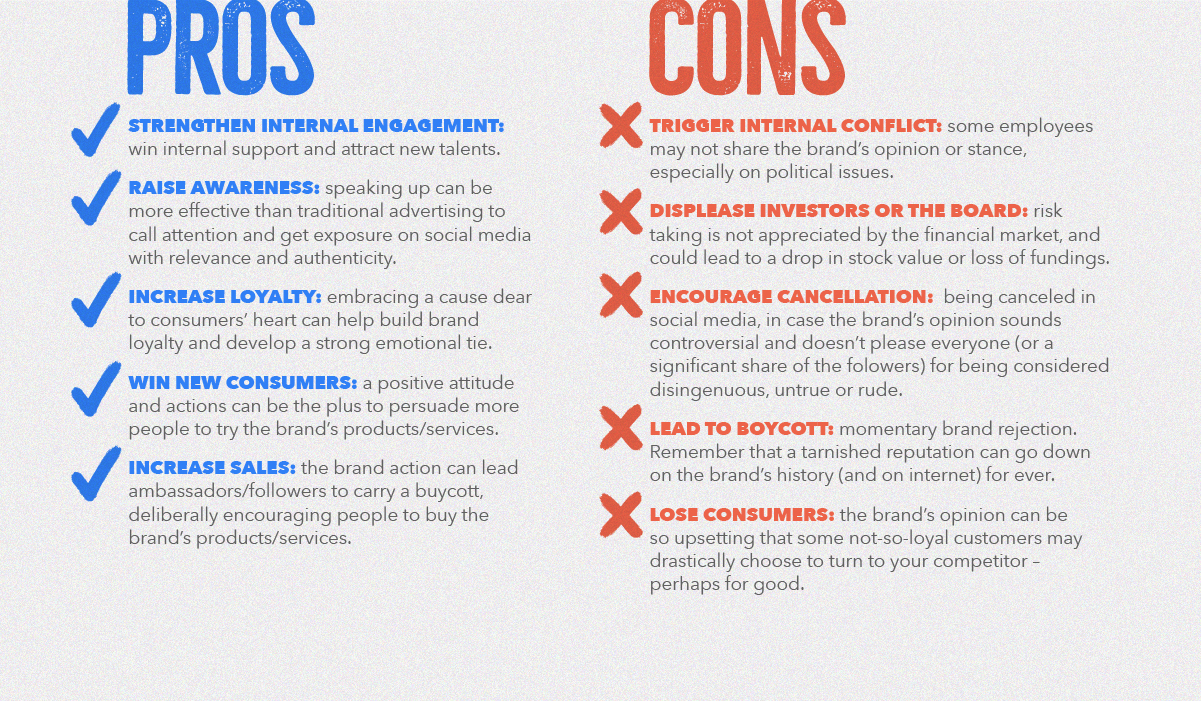France
Paris
Switch to your local agency
Back to menu
Welcome to

Brand activism is nothing new. The importance of having a clear purpose has been extensely discussed for decades. Aligned with this foremost intention comes the necessity to define which causes a brand wants to support, meeting the demands of an audience that craves for more humane and coherent stances. Nowadays, brands have to stand for more than just profit: they are expected to contribute to building a better society.
The uncontrolled pandemic, the polarization of society, the stronger presence of social media and the growing cancel culture have boosted the game. What used to be an opportunity, is now a requirement – at times, essential for the survival. Brands have to build a positive impact territory; the mere position of trading goods and services, coupled with the neutrality towards relevant issues such as racism, gender, feminism and environment, is no longer a strong enough offer. Not taking a stand may give rise to the impression of consent, while stating an opinion can be seen as hypocrisy – if the talk is not followed by concrete actions, aligned with the brand’s DNA – depleting the brand’s value.
Thus, brands must take a clear stance and genuinely commit to one or more causes to remain competitive. The challenge faced is how to approach it constructively, being faithful to the brand’s values and not sounding self-serving, besides being careful to minimize the risks of boycott in an increasingly demanding environment where one slip can be fatal.
Bearing this challenging and intriguing setting in mind, we propose some reflections to help brands understand the different possible types and levels of activism, the risks and benefits of speaking up. Paths that, when followed with truth and transparency, can lead to a real and long-lasting commitment.
We all know, there is no single way to engage, and there is no right or wrong. We suggest below an ‘activism profile classification’ based on the brand’s DNA and its intended relation with its stakeholders, more than on the company’s size or category. Here they are:

Superactivists
Brands that are activists since foundation, deeply engaged with causes related to the brand’s core values, and supported by the founding partners or CEOs themselves. They believe that action speaks louder than words, and they take to the streets with its public to be heard and actually aim to achieve social change. They create a strong emotional tie with its fans, so much that they usually become brand ambassadors.
Paradigm-breakers
Innovative brands, pioneers in their respective businesses since foundation. Their own core products or services are their flags, since their proposal is to change patterns and break a category status quo. They usually forge an emotional bond with their consumer base, for meeting previously unmet needs.
So, when is it worth to engage and get political about a current cause or issue? For Carolina Barruffini, CBA B+G Branding director, brands have to be more daring: “No doubt there are some risks involved when brands engage in relevant causes. However, many real examples have showed us that taking action is better than not taking a stand, even if there’s little impact – provided that the action is driven by truth and transparency.”
We listed below the pros and cons that every brand must consider before taking a stand.

How then, can brand activism be a long-term, authentic and minimal-risk commitment? We suggest 8 steps to make it happen. It is a long journey, however it can surely put you on the right track to remain relevant in the future.
The 8 steps for achieving Positive Impact are:
1. Define a clear and powerful brand positioning
What is the brand reason for being, its beliefs? What is the brand’s DNA, its personality, its target audience? Branding for the future – a playbook with thoughts on how to reconnect brands, consumer and market – the three fundamental business spheres (which are still more importante in times of pandemic) – is a way to help you understand the brand context and its actions. Learn more about it here.
2. Choose your battles
Based on the brand core values – and aligned with them –identify the causes that the brand has credibility to support.
3. Define the stakeholders
Besides the target audience and brand consumers, who else does the brand impact, directly or indirectly, externally or internally? Stakeholders include employees and their family, board and investors, influencers, specialized media, government and social agents.
4. Look at the brand’s track record (and its present moment)
Although the brand purpose may have evolved over the years, the brand’s past cannot be ignored. It’s important to revisit previous actions, statements and campaigns to assess the credibility of engaging on a topic. And, sometimes, make a mea culpa (Skol has done this in 2017, who remembers?). Also, reputation must be considered; if it is fragile, spotlighting your brand may not be the best move.
5. Define the brand activism profile
Among the different profiles – superactivist, paradigm breaker, daring, responsible – which makes more sense for your brand today and which it aspires for the future?
6. Identify potential risks
The more renowned the brand is, the more important it is to assess the risks and benefits of taking a stance – or of staying neutral.
7. Walk the talk
Promises, great speeches or fierce campaigns are not enough to guarantee a brand’s survival without significant and real actions to support them. Consumers expect the brand (company) to engage in a realistic and tangible way, and if it doesn’t, they will ask for it.
8. Listen to feedback
Stakeholders feedback deserve attention. The brand must learn from its mistakes and successes and act quickly. Monitoring the brand’s “promises versus deliveries” can be decisive for the brand’s health and reputation.
Would you like to delve deeper into the topics of activism, brands and branding? We recommend: watching the interview with Rose Marcaria – Patagonia President and CEO – for Stanford students; listening to the episode Ativismo nos dias atuais (Today’s activism), from the podcast “O Tempo Virou” by Giovanna Nader, with the social activist Alessandra Orofino; and last but not least, reading this excellent article on the importance of taking risks, written by brand strategist Jasmine Bina.
You can always get in touch with us if you wanna chat about the challenges and opportunities for your brand. And if this subject inspires you and you are or know business professionals, strategists and designers who are interested in being part of our team, send an e-mail to [email protected] with expectations, goals and stories. We are always looking for new talents!
The content of this article had the contribution of: Carmen Beer, Ana Cerqueira, Giuliana Sanchez, Thaísa Miyahara, Carolina Barrufini, Ana Biselli, Renato Storni, José F. Ramirez, Fabiana Quiroga, Josy Lamenza, Daniela Irrazabal, and Luis Bartolomei.
Subscribe and receive CBA’s latest news directly in your inbox!
Privacy Overview
| Cookie | Duration | Description |
|---|---|---|
| cookielawinfo-checbox-analytics | 11 months | This cookie is set by GDPR Cookie Consent plugin. The cookie is used to store the user consent for the cookies in the category "Analytics". |
| cookielawinfo-checbox-functional | 11 months | The cookie is set by GDPR cookie consent to record the user consent for the cookies in the category "Functional". |
| cookielawinfo-checbox-others | 11 months | This cookie is set by GDPR Cookie Consent plugin. The cookie is used to store the user consent for the cookies in the category "Other. |
| cookielawinfo-checkbox-advertisement | 1 year | The cookie is set by GDPR cookie consent to record the user consent for the cookies in the category "Advertisement". |
| cookielawinfo-checkbox-necessary | 11 months | This cookie is set by GDPR Cookie Consent plugin. The cookies is used to store the user consent for the cookies in the category "Necessary". |
| cookielawinfo-checkbox-performance | 11 months | This cookie is set by GDPR Cookie Consent plugin. The cookie is used to store the user consent for the cookies in the category "Performance". |
| viewed_cookie_policy | 11 months | The cookie is set by the GDPR Cookie Consent plugin and is used to store whether or not user has consented to the use of cookies. It does not store any personal data. |
| Cookie | Duration | Description |
|---|---|---|
| aka_debug | This cookie is set by the provider Vimeo.This cookie is essential for the website to play video functionality. The cookie collects statistical information like how many times the video is displayed and what settings are used for playback. | |
| player | 1 year | This cookie is used by Vimeo. This cookie is used to save the user's preferences when playing embedded videos from Vimeo. |
| pll_language | 1 year | This cookie is set by Polylang plugin for WordPress powered websites. The cookie stores the language code of the last browsed page. |
| Cookie | Duration | Description |
|---|---|---|
| _gat | 1 minute | This cookies is installed by Google Universal Analytics to throttle the request rate to limit the colllection of data on high traffic sites. |
| YSC | session | This cookies is set by Youtube and is used to track the views of embedded videos. |
| Cookie | Duration | Description |
|---|---|---|
| _ga | 2 years | This cookie is installed by Google Analytics. The cookie is used to calculate visitor, session, campaign data and keep track of site usage for the site's analytics report. The cookies store information anonymously and assign a randomly generated number to identify unique visitors. |
| _gid | 1 day | This cookie is installed by Google Analytics. The cookie is used to store information of how visitors use a website and helps in creating an analytics report of how the website is doing. The data collected including the number visitors, the source where they have come from, and the pages visted in an anonymous form. |
| vuid | 1 years | This domain of this cookie is owned by Vimeo. This cookie is used by vimeo to collect tracking information. It sets a unique ID to embed videos to the website. |
| Cookie | Duration | Description |
|---|---|---|
| IDE | 1 year 24 days | Used by Google DoubleClick and stores information about how the user uses the website and any other advertisement before visiting the website. This is used to present users with ads that are relevant to them according to the user profile. |
| test_cookie | 15 minutes | This cookie is set by doubleclick.net. The purpose of the cookie is to determine if the user's browser supports cookies. |
| VISITOR_INFO1_LIVE | 5 months 27 days | This cookie is set by Youtube. Used to track the information of the embedded YouTube videos on a website. |
| Cookie | Duration | Description |
|---|---|---|
| CONSENT | 3 years | No description |